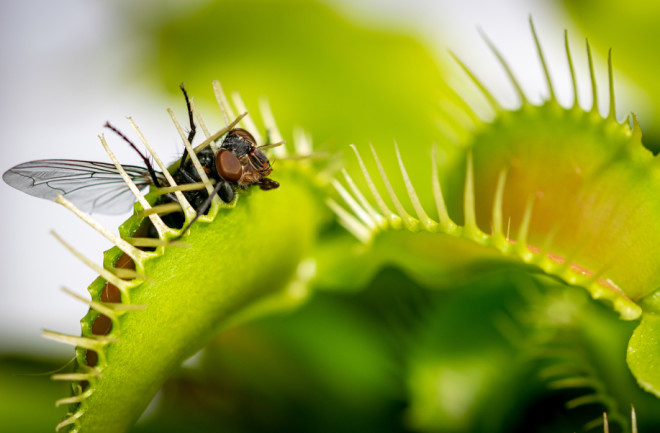Around the world today, you’ll find at least 700 different kinds of carnivorous plants, ranging from pitcher plants that lure their victims into pools of digestive enzymes to adhesive-trap plants whose stalks secrete a natural glue, turning them into living flypaper.
The fossil record contains evidence of early predator plants dating as far back as 40 million years, although many such plants likely existed much earlier than that. As fascinating as these plants are, none have captured the human imagination in the way that the Venus flytrap has.
Everything to Know About the Venus Flytrap
Known to science as Dionaea muscipula, the Venus flytrap is by far the most popular and well-known of predatory plants. Western botanists began writing about it in the 1700s, supposedly naming the flytrap after the goddess Venus because of the plant's beauty when it produces flowers (although there are other less genteel theories about the name).
Even Charles Darwin was captivated by this perennial, which is indigenous to the southeastern United States (mainly North and South Carolina). Fascinated by the “horrid prison” created by the flytrap’s distinctive spine-tipped leaves, which rapidly snap shut on unsuspecting prey, the great naturalist undertook an influential study of this and other carnivorous flora, culminating in his landmark 1875 work, Insectivorous Plants.
Read More: Venus Flytraps Count to 5 Before Dissolving Prey
Insect-Eating Plants
The idea that a mere plant could be a predator is something that has captivated generations of people. For a while, the very notion led to wild rumors of rapacious vegetation in far-flung corners of the world, large in both size and appetite.
Legends and lurid adventure tales of the late 19th and 20th centuries are full of stories of giant bloodthirsty plant life, lying in wait not merely to trap an insect, but to ensnare and snack upon much larger prey — like us.
Outside of such fantasies as Little Shop of Horrors, humans and other larger lifeforms have never been in any real danger from predatory plant life. Nevertheless, carnivores like the Venus flytrap were bound to accumulate certain myths and misconceptions over the years. Here’s what we really know about these captivating capturers of animal life.
Read More: Top 5 Carnivorous Plants of North America
How Do Venus Flytraps Work?
For starters, the Venus flytrap and other carnivorous plants do not derive the bulk of their energy from the creatures they capture. Instead, they get most of their sustenance in the same way that every other plant does — through photosynthesis. For the flytrap, the very leaves that snap shut and ensnare unwary prey also trap sunlight for use in the photosynthetic process.
So why bother trapping creatures and devouring them? It’s understood that the Venus flytrap and other carnivorous plants evolved their predatory techniques to compensate for certain nutrient deficiencies in the soil where they grow. If they couldn’t get critical types of sustenance from the ground, then they had to develop methods of capturing it — literally — from some other source. In that regard, the insects a flytrap snares are essentially nutritional supplements.
Read More: Is Dirt Just Worm Poop? Digging Up the Secrets of Soil
What Do Venus Flytraps Eat?
Having said that, the plant’s name is a little misleading: The Venus flytrap doesn’t actually get a lot of flies in its diet — winged insects account for perhaps 5 percent of its prey. The plant secretes scents to attract a range of creatures, but mostly it feeds on ants and spiders, plus the occasional beetle or grasshopper, whenever it can catch one.
Although it doesn’t commonly happen in nature, in the right circumstances, large flytraps are capable of consuming small frogs, snakes and possibly even rodents. It really depends on the size of the plant relative to the prey; if it fits inside the space of the leaves that form the trap, the plant will try to snare it.
Read More: Meet 10 of the World's Most Adorable Frogs
Can a Venus Flytrap Hurt You?
And if you’ve ever asked yourself “What would happen if I stuck my finger in a Venus flytrap?” the answer is: Nothing much.
You might get the trap to close around the tip of your finger, but the spines on the edge of the trap won’t hurt you and the trap would have to be completely closed before the plant would secrete any digestive enzymes.
Nevertheless, it’s best not to stick your finger in a Venus flytrap, since you risk doing more harm to plant than anything else.
Read More: Why Did Carnivorous Plants Become Meat Eaters?
Is the Venus Flytrap Endangered?
Venus flytraps already have plenty of risks to deal with. They are themselves known to be consumed by squirrels and birds. Even some bugs, such as aphids, can be a problem for them. Although not listed as endangered (yet), Venus flytraps in the wild are considered vulnerable.
According to the U.S. Fish and Wildlife Service, the biggest threats to wild populations are human poaching and encroaching. Although it’s a felony in some areas where the plants grow, the predatory perennial’s popularity is such that plenty of unscrupulous people will still illegally harvest wild flytraps for sale as decorative and potted plants.
Meanwhile, human encroachment in the form of agriculture, land development and other depredations have led to large-scale decline and destruction of the Venus flytrap’s natural habitat. Bear that in mind the next time you see an attractive flytrap in a pot at your local garden center. Then ask yourself: Who really is the predator and who is the prey?
Read More: 5 of the Strangest Looking Flowers

